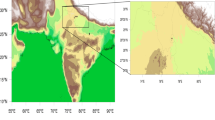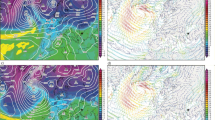Abstract
A series of numerical simulations is conducted to understand the formation, evolution, and dissipation of an advection fog event over Shanghai Pudong International Airport (ZSPD) with the Weather Research and Forecasting (WRF) model. Using the current operational settings at the Meteorological Center of East China Air Traffic Management Bureau, the WRF model successfully predicts the fog event at ZSPD. Additional numerical experiments are performed to examine the physical processes associated with the fog event. The results indicate that prediction of this particular fog event is sensitive to microphysical schemes for the time of fog dissipation but not for the time of fog onset. The simulated timing of the arrival and dissipation of the fog, as well as the cloud distribution, is substantially sensitive to the planetary boundary layer and radiation (both longwave and shortwave) processes. Moreover, varying forecast lead times also produces different simulation results for the fog event regarding its onset and duration, suggesting a trade-off between more accurate initial conditions and a proper forecast lead time that allows model physical processes to spin up adequately during the fog simulation. The overall outcomes from this study imply that the complexity of physical processes and their interactions within the WRF model during fog evolution and dissipation is a key area of future research.
Similar content being viewed by others
References
Bang, C. H., J. W. Lee, and S. Y. Hong, 2009: Predictability experiments of fog and visibility in local airports over Korea using the WRF model. J. Korean Soc. Atmos. Environ., 24, 92–101.
Bari, D., T. Bergot, and M. El Khlifi, 2015: Numerical study of a coastal fog event over Casablanca, Morocco. Quart. J. Roy. Meteor. Soc., 141, 1894–1905, doi: 10.1002/qj.2494.
Bergot, T., and D. Guedalia, 1994: Numerical forecasting of radiation fog. Part I: Numerical model and sensitivity tests. Mon. Wea. Rev., 122, 1218–1230, doi: 10.1175/1520-0493(1994)122<1218:NFORFP>2.0.CO;2.
Bergot, T., E. Terradellas, J. Cuxart, et al., 2007: Intercomparison of single-column numerical models for the prediction of radiation fog. J. Appl. Meteor. Climatol., 46, 504–521, doi: 10.1175/JAM2475.1.
Bieringer, P. E., M. Donovan, F. Robasky, et al., 2006: A characterization of NWP ceiling and visibility forecasts for the terminal airspace. Preprints, 12th Conference on Aviation Range and Aerospace Meteorology, Atlanta, GA, Amer. Meteor. Soc., 3 pp. [Accessed 10 July 2017 at http://ams.confex.com/ams/Annual2006/techprogram/paper_103720.htm].
Bott, A., and T. Trautmann, 2002: PAFOG—A new efficient forecast model of radiation fog and low-level stratiform clouds. Atmos. Res., 64, 191–203, doi: 10.1016/S0169-8095(02)00091-1.
Chen, F., and J. Dudhia, 2001: Coupling an advanced land surface–hydrology model with the Penn State–NCAR MM5 modeling system. Part I: Model implementation and sensitivity. Mon. Wea. Rev., 129, 569–585, doi: 10.1175/1520-0493(2001)129<0569:CAALSH>2.0.CO;2.
Clark, P. A., and W. P. Hopwood, 2001a: One-dimensional sitespecific forecasting of radiation fog. Part I: Model formulation and idealized sensitivity studies. Meteor. Appl., 8, 279–286, doi: 10.1017/S1350482701003036.
Clark, P. A., and W. P. Hopwood, 2001b: One-dimensional sitespecific forecasting of radiation fog. Part II: Impact of site observations. Meteor. Appl., 8, 287–296.
Creighton, G., E. Kuchera, R. Adams-Selin, et al., 2014: AFWA Diagnostics in WRF. [Accessed 10 July 2017 at http://www2.mmm.ucar.edu/wrf/users/docs/AFWA_Diagnostics_in_WRF.pdf].
Doran, J. A., P. J. Roohr, D. J. Beberwyk, et al., 1999: The MM5 at the Air Force Weather Agency—New products to support military operations. The 8th Conference on Aviation, Range, and Aerospace Meteorology, NOAA/NWS, Dallas, Texas.
Dudhia, J., 1989: Numerical study of convection observed during the Winter Monsoon Experiment using a mesoscale two-dimensional model. J. Atmos. Sci., 46, 3077–3107, doi: 10.1175/1520-0469(1989)046<3077:NSOCOD>2.0.CO;2.
Fabbian, D., R. de Dear, and S. Lellyett, 2007: Application of artificial neural network forecasts to predict fog at Canberra International Airport. Wea. Forecasting, 22, 372–381, doi: 10.1175/WAF980.1.
Fels, S. B., and M. D. Schwarzkopf, 1981: An efficient, accurate al-gorithm for calculating CO2 15 μm band cooling rates. J. Geo-phys. Res., 86, 1205–1232, doi: 10.1029/JC086iC02p01205.
Fu, Q., and K. N. Liou, 1992: On the correlated k-distribution method for radiative transfer in nonhomogeneous atmospheres. J. Atmos. Sci., 49, 2139–2156, doi: 10.1175/1520-0469(1992)049<2139:OTCDMF>2.0.CO;2.
Fu, G., P. Y. Li, J. G. Crompton, et al., 2010: An observational and modeling study of a sea fog event over the Yellow Sea on 1 August 2003. Meteor. Atmos. Phys., 107, 149–159, doi: 10.1007/s00703-010-0073-0.
Golding, B. W., 1993: A study of the influence of terrain on fog development. Mon. Wea. Rev., 121, 2529–2541, doi: 10.1175/1520-0493(1993)121<2529:ASOTIO>2.0.CO;2.
Gu, Y., K. N. Liou, S. C. Ou, et al., 2011: Cirrus cloud simulations using WRF with improved radiation parameterization and increased vertical resolution. J. Geophys. Res., 116, D06119, doi: 10.1029/2010JD014574.
Gultepe, I., and J. A. Milbrandt, 2010: Probabilistic parameterizations of visibility using observations of rain precipitation rate, relative humidity, and visibility. J. Appl. Meteor. Climatol., 49, 36–46, doi: 10.1175/2009JAMC1927.1.
Gultepe, I., M. D. Müller, and Z. Boybeyi, 2006: A new visibility parameterization for warm-fog applications in numerical weather prediction models. J. Appl. Meteor., 45, 1469–1480, doi: 10.1175/JAM2423.1.
Gultepe, I., R. Tardif, S. C. Michaelides, et al., 2007: Fog research: A review of past achievements and future perspectives. Pure Appl. Geophys., 164, 1121–1159, doi: 10.1007/s00024-007-0211-x.
Gultepe, I., B. Hansen, S. G. Cober, et al., 2009: The fog remote sensing and modeling field project. Bull. Amer. Meteor. Soc., 90, 341–359, doi: 10.1175/2008BAMS2354.1.
Gultepe, I., B. Zhou, J. Milbrandt, et al., 2015: A review on ice fog measurements and modeling. Atmos. Res., 151, 2–19, doi: 10.1016/j.atmosres.2014.04.014.
Hong, S. Y., and J. O. J. Lim, 2006: The WRF single-moment 6- class microphysics scheme (WSM6). J. Korean Meteor. Soc., 42, 129–151.
Hong, S. Y., Y. Noh, and J. Dudhia, 2006: A new vertical diffusion package with an explicit treatment of entrainment processes. Mon. Wea. Rev., 134, 2318–2341, doi: 10.1175/MWR 3199.1.
Hu, H. Q., Q. H. Zhang, B. G. Xie, et al., 2014: Predictability of an advection fog event over North China. Part I: Sensitivity to initial condition differences. Mon. Wea. Rev., 142, 1803–1822, doi: 10.1175/MWR-D-13-00004.1.
Iacono, M. J., J. S. Delamere, E. J. Mlawer, et al., 2008: Radiative forcing by long-lived greenhouse gases: Calculations with the AER radiative transfer models. J. Geophys. Res., 113, doi: 10.1029/2008JD009944.
Janjić, Z. I., 1994: The step-mountain eta coordinate model: Further developments of the convection, viscous sublayer, and turbulence closure schemes. Mon. Wea. Rev., 122, 927–945, doi:10.1175/1520-0493(1994)122<0927:TSMECM>2.0.CO;2.
Kain, J. S., 2004: The Kain–Fritsch convective parameterization: An update. J. Appl. Meteor., 43, 170–181, doi: 10.1175/1520-0450(2004)043<0170:TKCPAU>2.0.CO;2.
Kim, C. K., and S. S. Yum, 2012: A numerical study of sea-fog formation over cold sea surface using a one-dimensional turbulence model coupled with the Weather Research and Forecasting Model. Bound.-Layer Meteor., 143, 481–505, doi: 10.1007/s10546-012-9706-9.
Li, Y. P., and Y. X. Zheng, 2015: Analysis of atmospheric turbulence in the upper layers of sea fog. Chinese J. Oceanol. Limnol., 33, 809–818, doi: 10.1007/s00343-015-4030-0.
Lim, K. S. S., and S. Y. Hong, 2010: Development of an effective double-moment cloud microphysics scheme with prognostic cloud condensation nuclei (CCN) for weather and climate models. Mon. Wea. Rev., 138, 1587–1612, doi: 10.1175/2009MWR2968.1.
Lin, Y. L., R. D. Farley, and H. D. Orville, 1983: Bulk parameterization of the snow field in a cloud model. J. Climate Appl. Meteor., 22, 1065–1092, doi: 10.1175/1520-0450(1983)022<1065:BPOTSF>2.0.CO;2.
Mlawer, E. J., S. J. Taubman, P. D. Brown, et al., 1997: Radiative transfer for inhomogeneous atmospheres: RRTM, a validated correlated-k model for the longwave. J. Geophys. Res., 102, doi: 10.1029/97JD00237.
Morrison, H., G. Thompson, and V. Tatarskii, 2009: Impact of cloud microphysics on the development of trailing stratiform precipitation in a simulated squall line: Comparison of oneand two-moment schemes. Mon. Wea. Rev., 137, 991–1007, doi: 10.1175/2008MWR2556.1.
Nakanishi, M., and H. Niino, 2006: An improved Mellor–Yamada level-3 model: Its numerical stability and application to a regional prediction of advection fog. Bound.-Layer Meteor., 119, 397–407, doi: 10.1007/s10546-005-9030-8.
Niu, S. J., C. S. Lu, H. Y. Yu, et al., 2010: Fog research in China: An overview. Adv. Atmos. Sci., 27, 639–662, doi: 10.1007/s00376-009-8174-8.
Pagowski, M., I. Gultepe, and P. King, 2004: Analysis and modeling of an extremely dense fog event in southern Ontario. J. Appl. Meteor., 43, 3–16, doi: 10.1175/1520-0450(2004)043<0003:AAMOAE>2.0.CO;2.
Payra, S., and M. Mohan, 2014: Multirule based diagnostic approach for the fog predictions using WRF modelling tool. Adv. Meteor., 2014, 456065, doi: 10.1155/2014/456065.
Pleim, J. E., 2007: A combined local and nonlocal closure model for the atmospheric boundary layer. Part I: Model description and testing. J. Appl. Meteor. Climatol., 46, 1383–1395, doi: 10.1175/JAM2539.1.
Radi, A., A. A. Al-Katheri, and K. Al-Chergui, 2008: Evaluation of United Arab Emirates WRF two-way nested model on a set of thick coastal fog situations. [Accessed 10 July 2017 at http://www2.mmm.ucar.edu/wrf/users/workshops/WS2008/ab stracts/P8-06.pdf].
Rémy, S., O. Pannekoucke, T. Bergot, et al., 2012: Adaptation of a particle filtering method for data assimilation in a 1D numerical model used for fog forecasting. Quart. J. Roy. Meteor. Soc., 138, 536–551, doi: 10.1002/qj.v138.663.
Román-Cascón, C., C. Yagüe, M. Sastre, et al., 2012: Observations and WRF simulations of fog events at the Spanish Northern Plateau. Adv. Sci. Res., 8, 11–18, doi: 10.5194/asr-8-11-2012.
Román-Cascón, C., G. J. Steeneveld, C. Yagüe, et al., 2016: Forecasting radiation fog at climatologically contrasting sites: Evaluation of statistical methods and WRF. Quart. J. Roy. Meteor. Soc., 142, 1048–1063, doi: 10.1002/qj.2016.142.issue-695.
Skamarock, W. C., J. B. Klemp, J. Dudhia, et al., 2008: A Description of the Advanced Research WRF Version 3. NCAR Technical Note, NCAR/TN-475+STR, doi: 10.5065/D68S4MVH.
Steeneveld, G. J., R. J. Ronda, and A. A. M. Holtslag, 2015: The challenge of forecasting the onset and development of radiation fog using mesoscale atmospheric models. Bound.-Layer Meteor., 154, 265–289, doi: 10.1007/s10546-014-9973-8.
Stoelinga, M. T., and T. T. Warner, 1999: Nonhydrostatic, mesobeta-scale model simulations of cloud ceiling and visibility for an East Coast winter precipitation event. J. Appl. Meteor., 38, 385–404, doi: 10.1175/1520-0450(1999)038<0385:NMSMSO>2.0.CO;2.
Stolaki, S., I. Pytharoulis, and T. Karacostas, 2012: A study of fog characteristics using a coupled WRF–COBEL model over Thessaloniki airport, Greece. Pure Appl. Geophys., 169, 961–981, doi: 10.1007/s00024-011-0393-0.
Tang, Y. M., R. Capon, R. Forbes, et al., 2009: Fog prediction using a very high resolution numerical weather prediction model forced with a single profile. Meteor. Appl., 16, 129–141, doi: 10.1002/met.v16:2.
Tardif, R., 2007: The impact of vertical resolution in the explicit numerical forecasting of radiation fog: A case study. Pure Appl. Geophys., 164, 1221–1240, doi: 10.1007/s00024-007-0216-5.
Tardif, R., and R. M. Rasmussen, 2007: Event-based climatology and typology of fog in the New York city region. J. Appl. Meteor. Climatol., 46, 1141–1168, doi: 10.1175/JAM2516.1.
Thompson, G., P. R. Field, R. M. Rasmussen, et al., 2008: Explicit forecasts of winter precipitation using an improved bulk microphysics scheme. Part II: Implementation of a new snow parameterization. Mon. Wea. Rev., 136, 5095–5115, doi: 10.1175/2008MWR2387.1.
Tudor, M., 2010: Impact of horizontal diffusion, radiation and cloudiness parameterization schemes on fog forecasting in valleys. Meteor. Atmos. Phys., 108, 57–70, doi: 10.1007/s00703-010-0084-x.
Van der Velde, I. R., G. J. Steeneveld, B. G. J. W. Schreur, et al., 2010: Modeling and forecasting the onset and duration of severe radiation fog under frost conditions. Mon. Wea. Rev., 138, 4237–4253, doi: 10.1175/2010MWR3427.1.
von Glasow, R., and A. Bott, 1999: Interaction of radiation fog with tall vegetation. Atmos. Environ., 33, 1333–1346, doi: 10.1016/S1352-2310(98)00372-0.
Yuan, X., and Z. H. Chen, 2013: Statistics and monitoring analysis of advection fog at Shanghai Pudong Airport. J. Meteor. Sci., 33, 95–101, doi: 10.3969/2012jms.0149. (in Chinese)
Zhou, B. B., 2011: Introduction to A New Fog Diagnostic Scheme. NCEP Office Note 466, 43 pp. [Accessed 10 July 2017 at www.emc.ncep.noaa.gov/officenotes/newernotes/on466.pdf].
Zhou, B. B., and J. Du, 2010: Fog prediction from a multimodel mesoscale ensemble prediction system. Wea. Forecasting, 25, 303–322, doi: 10.1175/2009WAF2222289.1.
Zhou, B. B., J. Du, I. Gultepe, et al., 2012: Forecast of low visibility and fog from NCEP: Current status and efforts. Pure Appl. Geophys., 169, 895–909, doi: 10.1007/s00024-011-0327-x.
Author information
Authors and Affiliations
Corresponding author
Additional information
Supported by the National Natural Science Foundation of China (4130511 and U1233138) and Safety Capability Enhancement Program of Civil Aviation Administration of China (TMSA1605).
Rights and permissions
About this article
Cite this article
Lin, C., Zhang, Z., Pu, Z. et al. Numerical simulations of an advection fog event over Shanghai Pudong International Airport with the WRF model. J Meteorol Res 31, 874–889 (2017). https://doi.org/10.1007/s13351-017-6187-2
Received:
Accepted:
Published:
Issue Date:
DOI: https://doi.org/10.1007/s13351-017-6187-2




